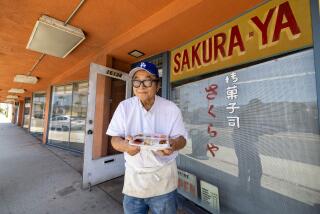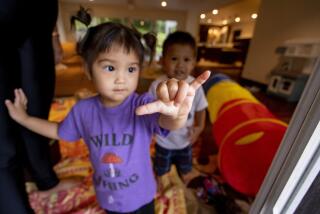A Taste of Old Japan in New Year Rite : Children Treated to Traditional Observance
These days, muses Gerald Yoshitomi, the closest that many Japanese-American youngsters get to the culture of their homeland is when they play “Nintendo” video games.
With the Japanese New Year ( Oshogatsu ) coming up Sunday, the Japanese American Cultural and Community Center is seeking to change that.
On Wednesday, the Little Tokyo-based center, where Yoshitomi serves as director, played host to 35 Japanese-American elementary school students for a program focusing on the traditional celebration of the Japanese New Year.
Unlike in the United States, where the closest thing to a New Year’s tradition is nursing a hangover and watching football games, the Japanese culture features a wide assortment of religious, cultural and social New Year’s traditions, said program director Chris Aihara.
In Japan, families traditionally eat osechi ryori (a special meal that includes roasted sea bream, hulled chestnuts and herring roe), visit neighbors and attend a Buddhist service in which a bell is tolled 108 times to cast away sins.
“Everything is symbolic,” said Aihara, “and there is a feeling that if you begin the New Year properly, the year will go well.”
On a normal school vacation day, 8-year-old Jared Watanabe would probably be watching TV, playing baseball or going to Disneyland.
But on Wednesday, the Whittier third-grader eagerly prepared mochi (sweet rice cakes), placed them in a sanbo (a colorful box made from folded paper), and viewed a performance of the New Year’s shishimai (lion dance).
Year of the Snake
Jared and the other youngsters, mostly third- or fourth-generation Japanese-Americans, also watched a Japanese calligrapher paint a sumi-e (ink painting) of a black snake on a piece of wood.
“1989 is the Year of the Snake in Japan,” explained Aihara. “It’s not the evil symbol that it is in the Western culture. A snake is characterized as elegant, meticulous.”
Several youngsters proceeded to paint snakes themselves, including Jenifer Uyeda of Gardena, who was born in 1977, the previous Year of the Snake in the 12-year animal zodiac.
Not everyone, though, bowed to tradition.
Derek Miyamoto, 8, of West Los Angeles, used his marking pen to sketch a baseball diamond and then scrawled the word “Nintendo” over it. Even the program itself assented to a degree of assimilation.
Rather than making the mochi from scratch, “we made it in a machine, because it’s too much work otherwise,” asserted a smiling Aihara. “That’s the way we do things now.”
The youngsters, few of whom speak Japanese, seemed to have the most fun shaping the ready-to-eat cakes.
“The first thing to go is the language, but the last thing to go is the food,” noted Johnny Mori, a dancer and professional jazz percussionist who performed the lion dance for the children.
More to Read
Sign up for The Wild
We’ll help you find the best places to hike, bike and run, as well as the perfect silent spots for meditation and yoga.
You may occasionally receive promotional content from the Los Angeles Times.






